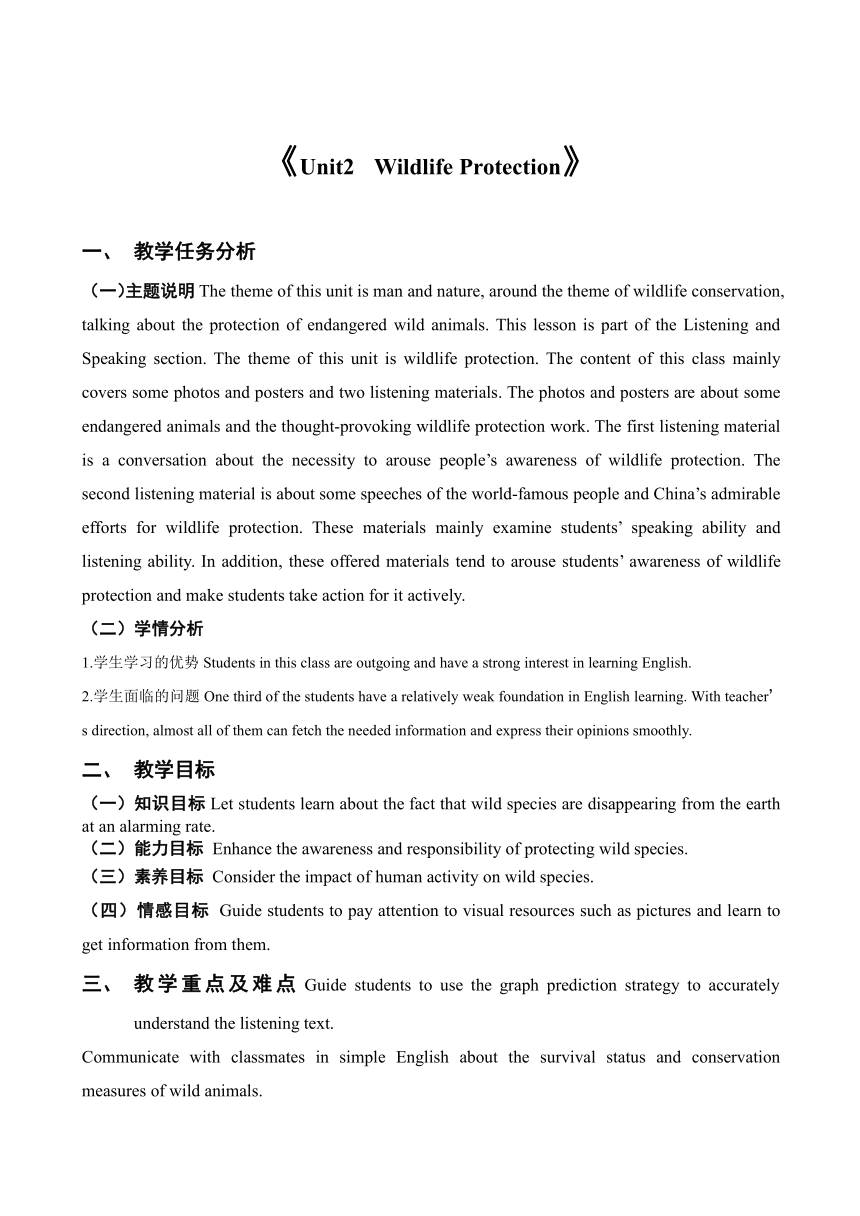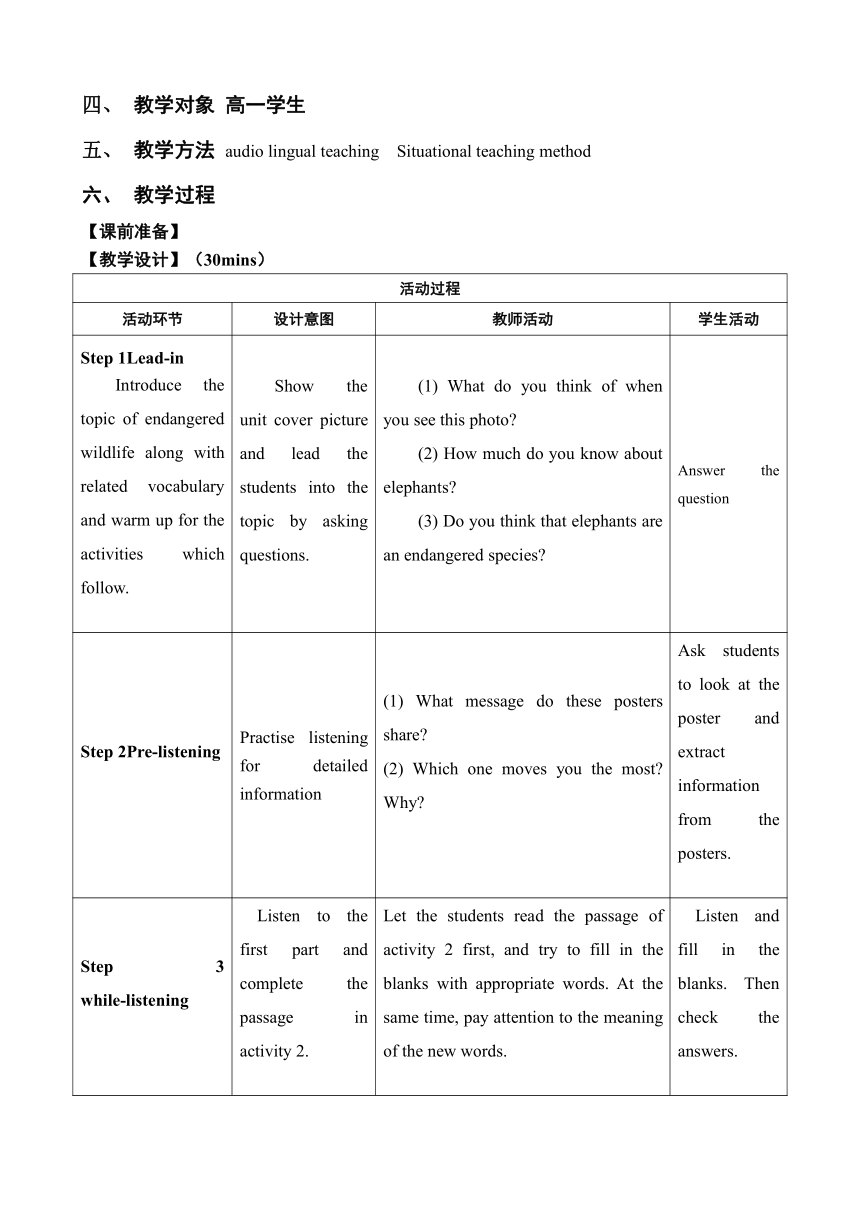人教版(2019)必修第二册Unit 2 Wildlife protection Listening and Speaking 教学设计(表格式)
文档属性
| 名称 | 人教版(2019)必修第二册Unit 2 Wildlife protection Listening and Speaking 教学设计(表格式) |  | |
| 格式 | docx | ||
| 文件大小 | 22.3KB | ||
| 资源类型 | 教案 | ||
| 版本资源 | 人教版(2019) | ||
| 科目 | 英语 | ||
| 更新时间 | 2024-11-26 21:48:02 | ||
图片预览


文档简介
《Unit2 Wildlife Protection》
教学任务分析
(一)主题说明The theme of this unit is man and nature, around the theme of wildlife conservation, talking about the protection of endangered wild animals. This lesson is part of the Listening and Speaking section. The theme of this unit is wildlife protection. The content of this class mainly covers some photos and posters and two listening materials. The photos and posters are about some endangered animals and the thought-provoking wildlife protection work. The first listening material is a conversation about the necessity to arouse people’s awareness of wildlife protection. The second listening material is about some speeches of the world-famous people and China’s admirable efforts for wildlife protection. These materials mainly examine students’ speaking ability and listening ability. In addition, these offered materials tend to arouse students’ awareness of wildlife protection and make students take action for it actively.
(二)学情分析
1.学生学习的优势Students in this class are outgoing and have a strong interest in learning English.
2.学生面临的问题One third of the students have a relatively weak foundation in English learning. With teacher’s direction, almost all of them can fetch the needed information and express their opinions smoothly.
教学目标
知识目标Let students learn about the fact that wild species are disappearing from the earth at an alarming rate.
(二)能力目标 Enhance the awareness and responsibility of protecting wild species.
(三)素养目标 Consider the impact of human activity on wild species.
(四)情感目标 Guide students to pay attention to visual resources such as pictures and learn to get information from them.
教学重点及难点Guide students to use the graph prediction strategy to accurately understand the listening text.
Communicate with classmates in simple English about the survival status and conservation measures of wild animals.
教学对象 高一学生
教学方法 audio lingual teaching Situational teaching method
教学过程
【课前准备】
【教学设计】(30mins)
活动过程
活动环节 设计意图 教师活动 学生活动
Step 1Lead-in Introduce the topic of endangered wildlife along with related vocabulary and warm up for the activities which follow. Show the unit cover picture and lead the students into the topic by asking questions. (1) What do you think of when you see this photo (2) How much do you know about elephants (3) Do you think that elephants are an endangered species Answer the question
Step 2Pre-listening Practise listening for detailed information (1) What message do these posters share (2) Which one moves you the most Why Ask students to look at the poster and extract information from the posters.
Step 3 while-listening Listen to the first part and complete the passage in activity 2. Let the students read the passage of activity 2 first, and try to fill in the blanks with appropriate words. At the same time, pay attention to the meaning of the new words. Listen and fill in the blanks. Then check the answers.
Step 4 discuss Give students a chance to apply what they have learnt in the previous listening activities through a discussion. (1) What do you know about the animals in the photos (2) What is being done to help them Wrap up and give students opportunities to apply what they have learnt in the previous listening activities through discussion and adapting a role-play.
Step5 Summary The greatness of a nation and its moral progress can be judged by the way its animals are treated. ——Mahatma Gandhi 一个国家的伟大和道德进步可以通过对待动物的方式来判断. ——圣雄甘地
Step6 homework Choose an endangered animal and describe it. You can refer to the examples in exercise 5. (1) What do you know about the animals in the photos (2) What is being done to help them
七、板书设计
Unit2 Wildlife Protection
Period 1.Listening and speaking
illegal adj.不合法的;非法的
illegal activities 违法行为;不法活动
on earth 究竟;到底
average n.平均数;平均水平adj.平均的;正常的;普通的
on average 平均
extinction n.灭绝
mass extinction 大量消亡
wildlife extinction 野生动物灭绝
habit n.习惯;惯常行为;习性
habitat n. (动植物的)生活环境; 栖息地
教学反思
通过本节内容学习,学生是否理解和掌握一系列关于野生动物的表达方式;
通过本节内容学习,学生能否掌握基本的预测能力,根据题干和关键词对对话或独白进行预测
教学任务分析
(一)主题说明The theme of this unit is man and nature, around the theme of wildlife conservation, talking about the protection of endangered wild animals. This lesson is part of the Listening and Speaking section. The theme of this unit is wildlife protection. The content of this class mainly covers some photos and posters and two listening materials. The photos and posters are about some endangered animals and the thought-provoking wildlife protection work. The first listening material is a conversation about the necessity to arouse people’s awareness of wildlife protection. The second listening material is about some speeches of the world-famous people and China’s admirable efforts for wildlife protection. These materials mainly examine students’ speaking ability and listening ability. In addition, these offered materials tend to arouse students’ awareness of wildlife protection and make students take action for it actively.
(二)学情分析
1.学生学习的优势Students in this class are outgoing and have a strong interest in learning English.
2.学生面临的问题One third of the students have a relatively weak foundation in English learning. With teacher’s direction, almost all of them can fetch the needed information and express their opinions smoothly.
教学目标
知识目标Let students learn about the fact that wild species are disappearing from the earth at an alarming rate.
(二)能力目标 Enhance the awareness and responsibility of protecting wild species.
(三)素养目标 Consider the impact of human activity on wild species.
(四)情感目标 Guide students to pay attention to visual resources such as pictures and learn to get information from them.
教学重点及难点Guide students to use the graph prediction strategy to accurately understand the listening text.
Communicate with classmates in simple English about the survival status and conservation measures of wild animals.
教学对象 高一学生
教学方法 audio lingual teaching Situational teaching method
教学过程
【课前准备】
【教学设计】(30mins)
活动过程
活动环节 设计意图 教师活动 学生活动
Step 1Lead-in Introduce the topic of endangered wildlife along with related vocabulary and warm up for the activities which follow. Show the unit cover picture and lead the students into the topic by asking questions. (1) What do you think of when you see this photo (2) How much do you know about elephants (3) Do you think that elephants are an endangered species Answer the question
Step 2Pre-listening Practise listening for detailed information (1) What message do these posters share (2) Which one moves you the most Why Ask students to look at the poster and extract information from the posters.
Step 3 while-listening Listen to the first part and complete the passage in activity 2. Let the students read the passage of activity 2 first, and try to fill in the blanks with appropriate words. At the same time, pay attention to the meaning of the new words. Listen and fill in the blanks. Then check the answers.
Step 4 discuss Give students a chance to apply what they have learnt in the previous listening activities through a discussion. (1) What do you know about the animals in the photos (2) What is being done to help them Wrap up and give students opportunities to apply what they have learnt in the previous listening activities through discussion and adapting a role-play.
Step5 Summary The greatness of a nation and its moral progress can be judged by the way its animals are treated. ——Mahatma Gandhi 一个国家的伟大和道德进步可以通过对待动物的方式来判断. ——圣雄甘地
Step6 homework Choose an endangered animal and describe it. You can refer to the examples in exercise 5. (1) What do you know about the animals in the photos (2) What is being done to help them
七、板书设计
Unit2 Wildlife Protection
Period 1.Listening and speaking
illegal adj.不合法的;非法的
illegal activities 违法行为;不法活动
on earth 究竟;到底
average n.平均数;平均水平adj.平均的;正常的;普通的
on average 平均
extinction n.灭绝
mass extinction 大量消亡
wildlife extinction 野生动物灭绝
habit n.习惯;惯常行为;习性
habitat n. (动植物的)生活环境; 栖息地
教学反思
通过本节内容学习,学生是否理解和掌握一系列关于野生动物的表达方式;
通过本节内容学习,学生能否掌握基本的预测能力,根据题干和关键词对对话或独白进行预测
